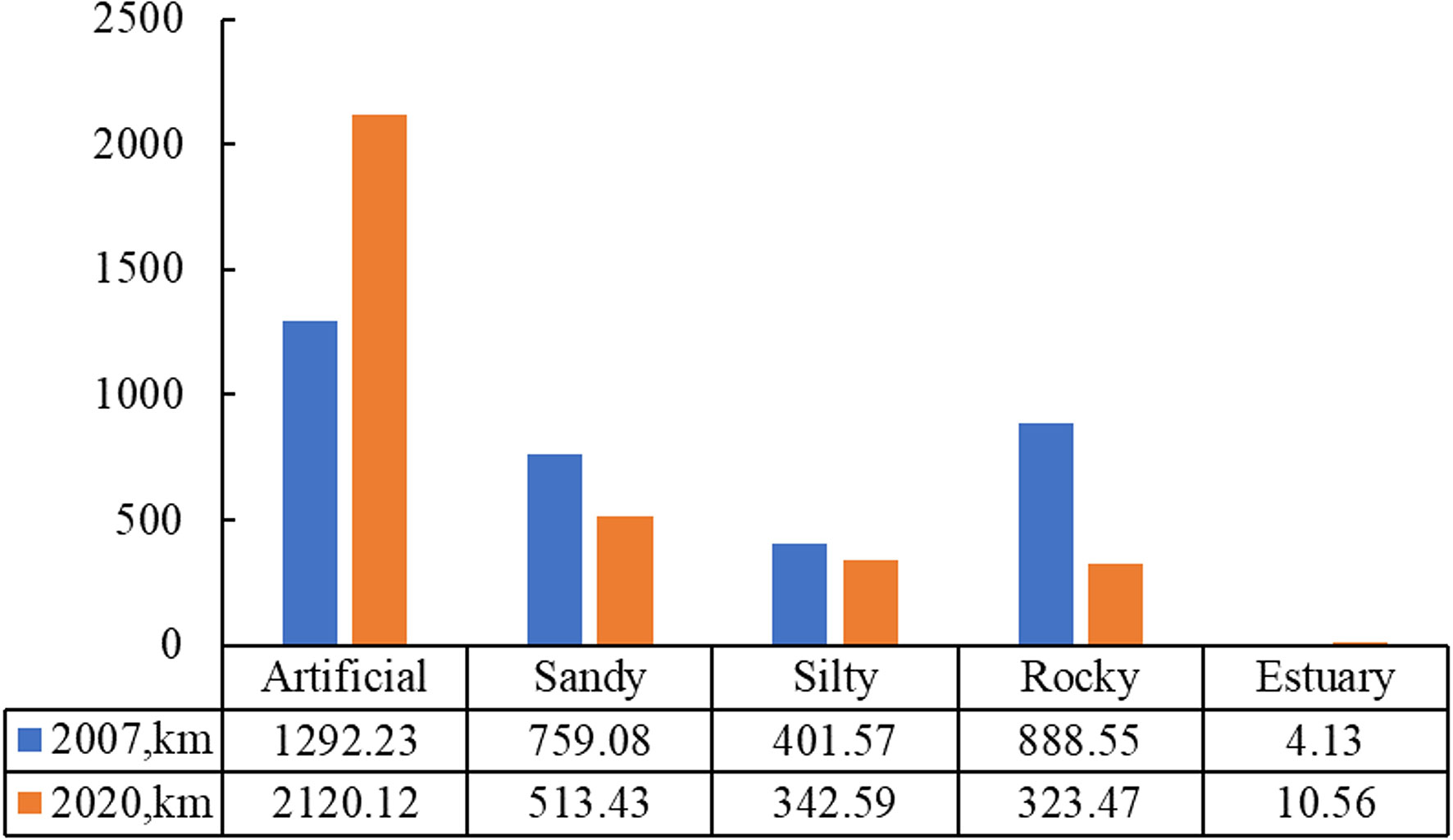
95% of researchers rate our articles as excellent or good
Learn more about the work of our research integrity team to safeguard the quality of each article we publish.
Find out more
CORRECTION article
Front. Mar. Sci. , 03 March 2023
Sec. Coastal Ocean Processes
Volume 10 - 2023 | https://doi.org/10.3389/fmars.2023.1160290
This article is a correction to:
Shoreline change due to global climate change and human activity at the Shandong Peninsula from 2007 to 2020
A Corrigendum on
Shoreline change due to global climate change and human activity at the Shandong Peninsula from 2007 to 2020
by Gao W, Du J, Gao S, Xu Y, Li B, Wei X, Zhang Z, Liu J and Li P (2023) Front. Mar. Sci. 9:1123067. doi: 10.3389/fmars.2022.1123067
In the published article, there was an error in Figure 3: “2009, km” was written instead of “2020, km”. The corrected Figure 3 is shown here.
In the published article, there was an error in Figure 8: “2009, km” was written instead of “2020, km”. The corrected Figure 8 is shown here.

Figure 8 Shoreline changes at the coastal cities of Shandong. BZ, Binzhou; DY, Dongying; WF, Weifang; YT, Yantai; WH, Weihai; QD, Qingdao; and RZ, Rizhao. See the locations of the shorelines in Figure 1.
In the published article, there was an error in the caption of Figure 12: “(C):2100” was written instead of “(C):2150”.
A correction has been made to 3 Results, “3.1 Shore-type changes”, paragraph 1, sentence 3. This sentence previously stated:
“The total shoreline length of Shandong in 2019 was 3310.18 km,…”
The corrected sentence appears below:
“The total shoreline length of Shandong in 2020 was 3310.18 km,…”
A correction has been made to 3 Results, “3.1 Shore-type changes”, paragraph 2, sentence 4. This sentence previously stated:
“During 2007–2009, not only did artificial shore account for the largest proportion of Shandong’s shoreline, but also it was the fastest growing shore type (Figure 3).”
The corrected sentence appears below:
“During 2007–2020, not only did artificial shore account for the largest proportion of Shandong’s shoreline, but also it was the fastest growing shore type (Figure 3).”
A correction has been made to an equation in 4 Discussion, “4.1 Shoreline change in association with global climate change”, “4.1.1 Effects of sea level rise”, paragraph 1. This equation previously stated:
The corrected equation appears below:
The authors apologize for these errors and state that this does not change the scientific conclusions of the article in any way. The original article has been updated.
All claims expressed in this article are solely those of the authors and do not necessarily represent those of their affiliated organizations, or those of the publisher, the editors and the reviewers. Any product that may be evaluated in this article, or claim that may be made by its manufacturer, is not guaranteed or endorsed by the publisher.
Keywords: global climate change, human activity, shoreline change, coastal erosion, sea level rise
Citation: Gao W, Du J, Gao S, Xu Y, Li B, Wei X, Zhang Z, Liu J and Li P (2023) Corrigendum: Shoreline change due to global climate change and human activity at the Shandong Peninsula from 2007 to 2020. Front. Mar. Sci. 10:1160290. doi: 10.3389/fmars.2023.1160290
Received: 07 February 2023; Accepted: 10 February 2023;
Published: 03 March 2023.
Edited and Reviewed by:
Yi Pan, Hohai University, ChinaCopyright © 2023 Gao, Du, Gao, Xu, Li, Wei, Zhang, Liu and Li. This is an open-access article distributed under the terms of the Creative Commons Attribution License (CC BY). The use, distribution or reproduction in other forums is permitted, provided the original author(s) and the copyright owner(s) are credited and that the original publication in this journal is cited, in accordance with accepted academic practice. No use, distribution or reproduction is permitted which does not comply with these terms.
*Correspondence: Jie Liu, bGl1amllQGZpby5vcmcuY24=; Ping Li, bGlwaW5nQGZpby5vcmcuY24=
Disclaimer: All claims expressed in this article are solely those of the authors and do not necessarily represent those of their affiliated organizations, or those of the publisher, the editors and the reviewers. Any product that may be evaluated in this article or claim that may be made by its manufacturer is not guaranteed or endorsed by the publisher.
Research integrity at Frontiers

Learn more about the work of our research integrity team to safeguard the quality of each article we publish.